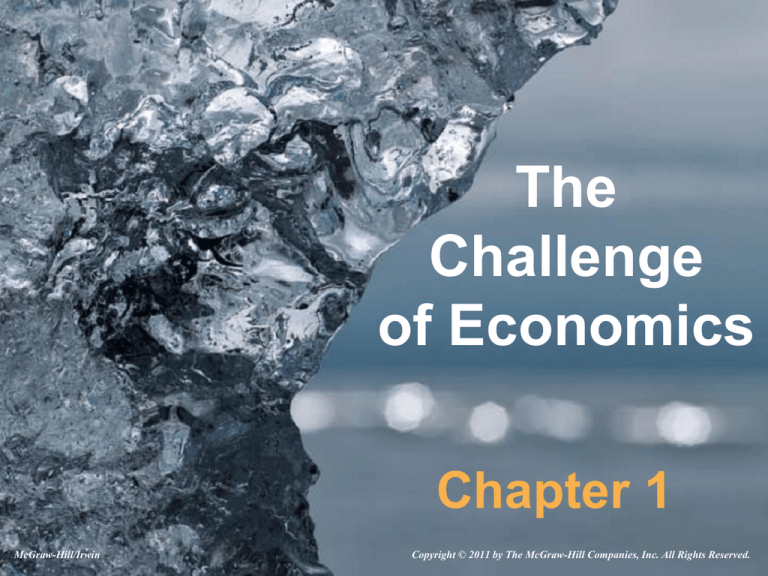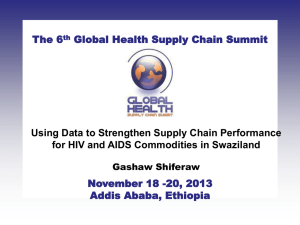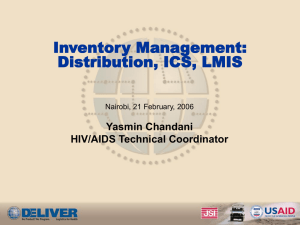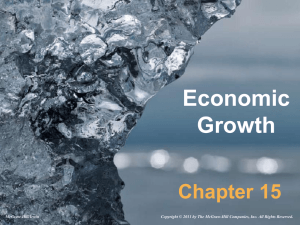
The
Challenge
of Economics
Chapter 1
McGraw-Hill/Irwin
Copyright © 2011 by The McGraw-Hill Companies, Inc. All Rights Reserved.
Economics and
Opportunity Cost
• Economics:
– The study of how best to allocate scarce
resources among competing uses.
• Opportunity Cost:
– The most desired goods and services that
are foregone in order to obtain something
else.
– The highest valued alternative that is
sacrificed for the chosen alternative.
1-3
LO-1
1-2
Factors of Production
• Resource inputs used to produce
goods and services.
• The four resources:
– Land, labor, capital, and
entrepreneurship.
1-4
LO-2
1-3
Scarcity
• Lack of available resources to satisfy
all desired uses of those resources.
• Central problem of economics.
1-5
LO-1
1-4
Three Basic Questions
• WHAT to produce
• HOW to produce
• FOR WHOM to produce
1-6
LO-3
1-5
Question 1:
WHAT to Produce?
• There aren’t enough resources in an
economy to produce all the goods and
services desired by society.
• We have to decide what we want most.
• We have to sacrifice less-desired
activities and goods.
LO-3
1-7
1-6
Production Possibilities
Curve
• Depicts the alternative combinations of
good and services than can be
produced given the quality and quantity
of the factors of production, including:
– Land – including natural resources
– Labor – number and skills of workers
– Capital – machinery, buildings, networks
– Entrepreneurship – skill in creating
products, services, and processes
1-8
LO-3
1-7
Figure 1.1
1-8
The Choices
Nations Make
• A nation must choose what to do with
its scarce resources during war or
periods of military buildup.
• Produce military goods (“guns”) or
consumer goods (“butter”)?
• Every time we increase missile
production, house construction must be
reduced.
1-10
LO-3
1-9
The Best Possible Mix
• There is only one best possible
(optimal) mix of output at any given
time.
• The first economic goal of any society
is to produce that optimal mix of
output—the optimal combination of
goods and services.
LO-3
1-12
1-10
Investment and
Economic Growth
• Investment:
– Expenditures on (production of) new plant
and equipment (capital) in a given time
period, plus changes in inventories.
• Economic growth:
– An increase in output (real GDP).
– An expansion of production possibilities
outward.
1-13
LO-3
1-11
Figure 1.5
1-12
Question #2:
HOW to Produce?
• The second economic goal for every
society is to find an optimal method of
producing goods and services.
LO-3
1-14
1-13
Question #3:
FOR WHOM to Produce?
• The “FOR WHOM” question focuses
on how an economy’s output is
distributed across members of society.
LO-3
1-15
1-14
FOR WHOM
to Produce
• The economic pie can be divided in
several ways:
– Distribution based on productive
contributions.
– Distribution based on need.
– Some combination of productive
contributions and need.
LO-3
1-16
1-15
Incentives
• Distribution based on need rather than
work effort may result in less work
effort.
• There is less output to distribute.
• The size of the pie may get smaller.
LO-3
1-17
1-16
Choice & the
Political Process
• There are conflicts and tradeoffs with
every choice.
• Many basic economic decisions are
made through the political process.
LO-4
1-18
1-17
The Market Mechanism
• The use of market prices and sales to
signal desired outputs (or resource
allocations).
• Market sales and prices send a signal
to producers about what mix of output
consumers want.
LO-4
1-19
1-18
The Market Mechanism
• Laissez faire is the doctrine of “leave it
alone,” or nonintervention by
government in the market mechanism.
• Adam Smith’s The Wealth of Nations
(1776) promoted laissez faire.
LO-4
1-20
1-19
Central Planning
• The government decides what goods
are produced, at what prices they are
sold, and who gets them.
• This mechanism of choice is
associated with Karl Marx.
LO-5
1-21
1-20
Mixed Economies
• Economies that use both market and
non-market signals to allocate goods
and resources.
• This represents a combination of the
other two systems.
• Most nations today are mixed
economies.
LO-5
1-22
1-21
Undesirable
Choices & Failure
• Markets don’t always produce the
“right” mix of output.
• Market Failure:
– An imperfection in the market mechanism
that prevents optimal outcomes.
LO-5
1-23
1-22
The Wrong
Mix of Output
• The market might produce too much of
some products and too little of other
products.
• The market might fail to make full use
of the economy’s production
possibilities (the Great Depression of
the 1930s and the Great Recession of
2008-09).
LO-5
1-24
1-23
Externalities
• Costs (or benefits) of a market activity
borne by a third party.
• The difference between the social and
private costs (or benefits) of a market
activity.
LO-5
1-26
1-24
Too Much Poverty
• Markets might fail to distribute goods
and services in the best possible way.
• Taxes and income transfers may be
used to reslice the economic pie.
• The Great Recession of 2008-09 saw
an increase in poverty through parts of
the world, including the United States.
LO-5
1-27
1-25
Government Failure
• Government intervention that fails to
improve economic outcomes.
• Government will not necessarily offer
better answers to the WHAT, HOW,
and FOR WHOM questions.
LO-5
1-28
1-26
Government Failure
• Government intervention might worsen
the mix of output.
• It might even reduce the total amount
of output through over-regulation.
• There is no guarantee that the visible
hand of government will be any cleaner
than the invisible hand of the
marketplace.
LO-5
1-29
1-27
Figure 1.7
1-28
What Economics
Is All About
• A combination of market signals and
government interventions forge better
answers to the WHAT, HOW, and FOR
WHOM questions.
• The first goal of economic theory is to
help society find better answers to the
three basic questions.
LO-3
1-30
1-29
What Economics
Is All About
• The second goal of economic theory is
to predict how changes in government
policy or market institutions will affect
economic outcomes.
LO-4
1-31
1-30
Macro versus Micro
• Macroeconomics is the study of
aggregate economic behavior, of the
economy as a whole.
• Microeconomics is the study of
individual behavior in the economy, of
the components or pieces of the larger
economy.
LO-1
1-32
1-31
Theory versus Reality
• Reality is too complex to describe and
explain in one course.
• Economists focus on basic
relationships and use these to predict
economic events and formulate
economic policies.
LO-1
1-33
1-32
Ceteris Paribus
• The assumption that nothing else is
changing.
• It is an important part of “thinking like
an economist”.
LO-1
1-34
1-33
Politics versus
Economics
• Economic theory can make significant
contributions to policy formulation.
• All policy decisions are ultimately a mix
of politics and economic theory.
• President Obama has made it clear
that he believes more government
intervention and less market reliance is
need to attain the right what, how, and
for whom answers.
LO-1
1-35
1-34
Appendix:
Using Graphs
• Graphs illustrate the relationship
between two variables.
1-37
1-35
Slopes
• Slope can show the relationship
between changes in study time and
changes in grade-point average.
vertical distance between tw o points
Slope
horizontal distance between tw o points
the rise
Slope
the run
1-38
1-36
Shifts
• When a curve shifts, the underlying
relationship between the two variables
has changed.
1-39
1-37
Figure A.2
1-38
Linear versus
Nonlinear Curves
• A linear curve has a constant slope
and is represented by a straight line.
• A nonlinear curve has a slope that
changes.
1-40
1-39
Causation
• A graph is a summary of empirical
observations.
• It says nothing about cause and effect.
1-41
1-40
End of
Chapter 1






